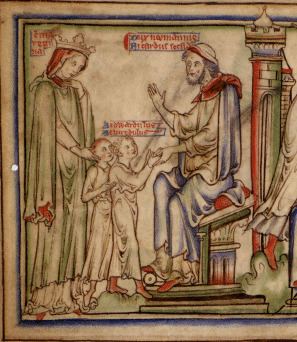Name Alfred Aetheling | Siblings Edward the Confessor | |
 | ||
Role AEthelred the Unready's son Died 1036, Ely, Cambridgeshire, United Kingdom Parents AEthelred the Unready, Emma of Normandy Grandparents Edgar the Peaceful, Richard I of Normandy, AElfthryth, wife of Edgar, Gunnora Similar People | ||
Ælfred Æþeling (English: Alfred the Noble) (c. 1005 – died 1036) was one of the eight sons of the English king Æthelred the Unready. He and his brother Edward the Confessor were sons of Ethelred's second wife Emma of Normandy. King Canute became their stepfather when he married Aethelred's widow. Alfred and his brother were caught in the power struggles at the start and end of Canute's reign.
Contents
Siege of London
In 1013 during the siege of London by the Danes, Aethelred and his family took refuge in Normandy. Aethelred regained the throne in 1014 and died in 1016. England was conquered by Canute of Denmark later that year, and Alfred and Edward returned to the court of their uncle, Duke Robert of Normandy. There is some evidence of a plan on the part of Duke Robert to invade England on his nephews' behalf.
Return to England
In 1035, Canute died, and during the uncertainty that followed, the heirs of the former Anglo-Saxon rulers attempted to restore the House of Wessex to the throne of England. Alfred Aetheling landed on the coast of Sussex with a Norman mercenary body guard and attempted to make his way to London. However he was betrayed, captured by Earl Godwin of Wessex, and blinded: he died soon afterwards.
In the Anglo-Saxon Chronicle there is an account of this fateful encounter:
When Harthacnut succeeded his half-brother Harold, he prosecuted Earl Godwin and Lyfing, Bishop of Worcester and Crediton, for the crime against his half-brother; the Bishop lost his see for a while and Godwin gave the king a warship carrying eighty fighting men as appeasement and swore that he had not wanted the prince blinded and that whatever he had done was in obedience to King Harold. Tradition holds that like Harthacnut, Edward the Confessor considered Godwin guilty.
The Anglo-Saxon House of Wessex was restored through the accession of Alfred's brother Edward in 1042. Alfred's death was one of the main reasons for the mistrust and resentment shown by many members of Anglo-Saxon society, and particularly from Edward himself, towards Earl Godwin and his sons.
Modern era
In 1929 the remains of 223 soldiers, whom excavators identified as Normans based on their stature, prominent skulls and slender leg bones, were found on the prominent hillside immediately west of Guildford's centre. They were bound and had been executed. The grave has been dated to c.1040. Some bore skulls placed between their legs and one skeleton in particular had a neck vertebra sliced by a sword. A coin of Edward the Confessor, Alfred's brother, dating to 1043AD - seven years after the mass slaying - was found at the site. An uncultivated sacred site, a small section of the burial ground dated back to the 6th century with more than 20 Pagan burials including many women and children, with knives, spears, urns and striking amber beads placed alongside various bodies. In charge of the excavations were Colonel O H North and archaeologist A W G Lowther. The later Chronicle suggests that they were the vanguard of Prince Alfred, of whom nine out of ten were killed.
